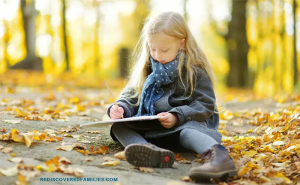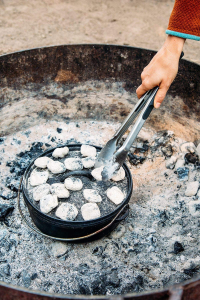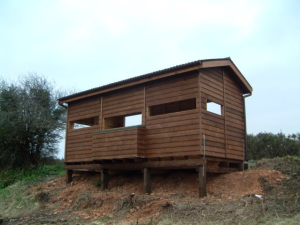Bushcraft is the art of living and thriving in the wilderness, utilizing skills and knowledge of the natural environment.
And what better way to introduce children to the wonders of bushcraft than through engaging and fun activities?
In this article, we will explore fun bushcraft ideas for kids.
Shelter Building:

One of the fundamental skills in bushcraft is knowing how to build a shelter to protect yourself from the elements. Encourage kids to explore their creativity by constructing their own shelters using natural materials such as sticks, leaves, and branches. They can start with a simple lean-to shelter or go all out with a more intricate design like a debris hut. Not only will this activity ignite their imagination, but it will also teach them valuable problem-solving skills and the importance of adapting to their surroundings.
Fire Starting:

Teaching kids how to start a fire safely is an essential bushcraft skill. Begin by explaining the principles of fire safety and the different methods of fire ignition. Show them how to gather tinder, kindling, and fuel wood, and demonstrate techniques like using a fire starter or a bow drill. Under close supervision, allow children to practice these skills themselves, fostering their self-confidence and teaching them the importance of fire as a survival tool in the wilderness.
Nature Scavenger Hunt:

A nature scavenger hunt is a fantastic way to engage children with their surroundings while teaching them about the flora and fauna of the wilderness. Create a list of items or clues related to the natural environment, such as different types of leaves, animal tracks, or specific rocks. Equip the kids with a small bag or basket and set them loose to explore and collect the items on their list. This activity not only sharpens their observation skills but also encourages a deeper appreciation for the biodiversity present in the great outdoors.
Related: 20 Fun Indoor Scavenger Hunt Clues for Kids
Navigation Skills:

Helping kids develop basic navigation & teamwork skills will not only make them feel like intrepid adventurers but also keep them safe in unfamiliar territory. Teach them how to use a compass, read maps, and navigate using natural landmarks. You can set up a treasure hunt where they must follow directions and use their newfound skills to locate hidden treasures. This activity combines learning with a sense of adventure and can inspire a lifelong love for exploration.
Edible Plant Identification:

Encourage children to explore the edible plants in their surroundings by teaching them how to identify them correctly. Start with a few common edible plants, such as dandelions or berries, and educate them about their characteristics and potential uses. Take them on a guided foraging walk where they can identify and collect edible plants, and later, prepare a simple and safe snack using their foraged finds. This activity not only enhances their knowledge of local flora but also instills a sense of self-sufficiency and respect for the resources provided by nature.
Related: 20 Easy Letter K Activities for Preschool
Wildlife Tracking:

Introduce kids to the art of wildlife tracking, teaching them how to identify and interpret animal tracks and signs. Take them on a nature walk and encourage them to observe the different tracks left by animals such as squirrels, birds, or deer. Teach them how to differentiate between tracks, identify the animal responsibly, and deduce its behavior. This activity will enhance their observational skills and deepen their understanding of animal behavior and the interconnectedness of nature.
Knot Tying:

Knot tying is a practical skill that every budding bush crafter should master. Show kids various essential knots used in camping and survival situations, such as the clove hitch, bowline, or taut-line hitch. Teach them the purpose and application of each knot and let them practice tying them using ropes or cords. This activity promotes fine motor skills, patience, and problem-solving abilities, while also empowering them to secure tents, build structures, and secure objects in the wilderness.
Natural Cordage Making:

Teach kids the ancient skill of making natural cordage using plant fibers. Show them how to identify suitable plants like stinging nettle, dogbane, or yucca, and guide them through the process of extracting and processing fibers to create strong and versatile cords. Once they have mastered the technique, encourage them to utilize their handmade cordage in other bushcraft activities, such as building shelters or crafting tools. This hands-on experience will develop their resourcefulness and connection with the natural world.
Campfire Cooking:
Combine the joy of cooking with outdoor adventure by introducing kids to campfire cooking. Teach them about the basics of campfire safety and demonstrate how to cook simple and delicious meals using traditional methods like skewers or foil packets. Let them assist in meal preparation, from gathering firewood to preparing ingredients, and encourage them to experiment with flavors and ingredients found in the wilderness. Campfire cooking not only fosters independence and self-sufficiency but also nurtures a love for wholesome and nature-inspired cuisine.
Nature Journaling:

Inspire kids to express their creativity and deepen their connection with nature through nature journaling. Provide them with journals and art supplies and encourage them to document their observations, experiences, and sketches of plants, animals, or landscapes during outdoor adventures. This activity promotes mindfulness, improves observation skills, and encourages a deeper appreciation for the beauty and intricacies of the natural world. Encourage kids to revisit their journals over time and witness their growth and understanding of the environment.
Nature Photography:

Introduce kids to the art of nature photography and encourage them to capture the beauty of the wilderness through their own lens. Provide them with cameras or smartphones and teach them basic photography techniques, such as framing, composition, and focusing. Take them on nature walks and challenge them to find unique angles and interesting subjects to photograph. This activity not only nurtures their creativity but also cultivates a deeper appreciation for the natural world as they discover its hidden wonders through the lens of a camera.
Outdoor Knotting Obstacle Course:

Create a fun and interactive knotting obstacle course for kids to test their knot-tying skills. Set up stations with different challenges where they have to tie specific knots within a time limit. For example, they may need to tie a secure knot to attach a tarp to a tree or tie a rope to create a makeshift ladder. This activity not only hones their knot-tying abilities but also enhances their agility, problem-solving skills, and ability to think quickly under pressure.
Birdhouse Building:

Teach kids the importance of providing shelter for wildlife by engaging them in birdhouse building. Provide them with pre-cut wooden pieces, nails, and a hammer, and guide them through the process of assembling a birdhouse. Teach them about different bird species, their nesting habits, and the placement of the birdhouse to attract specific birds. Hang the finished birdhouses in suitable locations, allowing children to witness and appreciate the joy of birds making their homes in their creations.
Outdoor Cooking Techniques:

Expand kids’ culinary skills by introducing them to various outdoor cooking techniques. Teach them how to cook on a camp stove, use Dutch ovens, or create a makeshift oven using rocks and fire. Demonstrate different methods like baking, grilling, or roasting and let them participate in preparing delicious meals using fresh ingredients. This activity not only exposes children to different cooking techniques but also encourages teamwork, creativity, and an understanding of how to utilize resources in a wilderness setting.
Nature Awareness Games:

Engage kids in nature awareness games that sharpen their senses and deepen their connection with the environment. Play games like “Blindfolded Listening” where they have to identify and locate sounds in nature, or “Nature I Spy” where they search for specific natural objects or phenomena. These games enhance their observation skills, encourage mindfulness, and foster a sense of wonder and curiosity about the world around them.
Nighttime Stargazing:

Introduce kids to the wonders of the night sky by organizing a stargazing adventure. Choose a location away from light pollution, lay out blankets, and teach them about constellations, planets, and other celestial objects. Use smartphone apps or star charts to help them identify and locate different stars and constellations. Encourage them to share their own stories or myths associated with the stars. This activity not only ignites their curiosity about the universe but also instills a sense of awe and wonder for the natural world.
Nature Crafts:

Engage children in creative nature crafts using materials found in the wilderness. Encourage them to collect leaves, twigs, feathers, and stones, and guide them in creating artwork, jewelry, or decorations. For example, they can make leaf rubbings, paint rocks, or weave bracelets using plant fibers. This activity nurtures their artistic abilities, promotes a sense of resourcefulness, and fosters an appreciation for the beauty and versatility of natural materials.
Outdoor First Aid Skills:

Teach kids basic outdoor first aid skills to prepare them for unexpected situations in the wilderness. Demonstrate how to clean and bandage minor cuts and scrapes, recognize and treat insect bites or stings, and address minor burns or sprains. Discuss the importance of emergency communication and teach them how to make improvised stretchers or splints using available resources. This activity not only empowers children with practical knowledge but also instills a sense of responsibility and preparedness when venturing into the great outdoors.
Wildlife Observation Hide:

Construct a wildlife observation hide together with the kids to create a hidden spot for observing and learning about wildlife. Use branches, foliage, or even a small tent to create a camouflaged shelter. Place it near a natural habitat, such as a pond, field, or forest edge. Spend time sitting quietly inside the hide, observing the behavior of birds, insects, or small mammals without disturbing them. This activity enhances their patience, observation skills, and understanding of ecosystems while fostering a deep respect for wildlife and their natural habitats.
Outdoor Navigation Challenge:
Organize an outdoor navigation challenge for kids to test their newfound navigation skills. Set up a course with checkpoints and provide them with a map and compass to navigate their way through the wilderness. Include challenges along the way that require them to solve riddles or find hidden objects. This activity not only reinforces their navigation abilities but also promotes teamwork, problem-solving, and critical thinking skills while having an exhilarating outdoor adventure.

